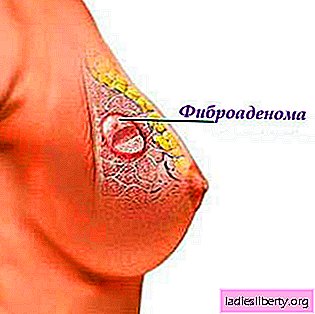
Fibroadenoma - A benign breast tumor that occurs most often in young women and girls under 30 years old. Any fibroadenoma consists of glandular cells and stromal or fibro-connecting cells.
As a rule, fibroadenoma has a diameter of 1-3 centimeters, however, fibroadenomas with a diameter of up to 5 centimeters are rare. Such large tumors are called giant fibroadenomas. In adolescents, fibroadenomas are sometimes called juvenile fibroadenomas.
Fibroadenoma - Causes
The cause of this neoplasm is an imbalance of hormones caused by the excessive prevalence of estrogen in the blood. It can be restored with progesterone, another female hormone that prevents the appearance of fluid. The balance is normalized as a result of the food diet, the basis of which is the limited use of chocolate and the rejection of caffeinated drinks.
Fibroadenoma - Symptoms
In most cases, the woman finds the fibroadenoma. A tumor in the mammary gland resembles an elastic rubber ball with a smooth surface. It has a fairly defined contour and is mobile. Sometimes fibroadenoma increases rapidly (possibly a twofold increase in a few months).
Fibroadenoma is almost always painless, but there are exceptions - it all depends on the position and size of the tumor. Most often, fibroadenoma is a single neoplasm, however, approximately 10% of patients have multiple fibroadenomas observed in both mammary glands.
Fibroadenoma cannot degenerate into cancer, with the exception of cases of leaf-shaped fibroadenoma. The total number of registered facts of the degeneration of fibroadenoma is negligible, therefore, it is hardly possible to talk about serious risk.
Fibroadenoma - diagnosis
Diagnosis of the disease begins with palpation and a thorough examination of the breast, then an ultrasound examination of the breast or mammography is performed. The final stage is a biopsy (taking a small piece of tissue and examining it under a microscope).
A biopsy is the only research method that can accurately determine whether a tumor is benign or malignant. A biopsy is done through a small incision, or using a needle. Young women and girls under 25 years of age are usually not prescribed a biopsy if the tumor under investigation has all the distinctive signs of fibroadenoma on an ultrasound and mammogram.
Fibroadenoma - treatment and prevention
In the presence of small fibroadenomas (up to one centimeter), dynamic observation is possible (ultrasound monitoring). Fibroadenoma cannot be cured with drugs. Neither hormone-containing agents, nor oral contraceptives, nor homeopathic remedies can eliminate fibroadenoma.
Indications for surgical removal of fibroadenoma:
- Suspicion of cancer (the tumor may simulate cancer during examination or on a mammogram);
- An intensive increase in fibroadenoma (when removing large tumors, cosmetic defects often appear and removal of fibroadenoma, if it grows rapidly, prevents these consequences);
- sufficiently large fibroadenomas that cause a cosmetic defect
The operation to remove fibroadenoma is considered the most easily tolerated in breast surgery, and the postoperative period is usually almost painless.
The only preventive measure for fibroadenoma is a timely and thorough self-examination or examination by a mammologist. It is impossible to prevent the formation of benign formations, but their degeneration into a malignant tumor can be prevented.











